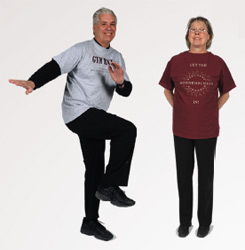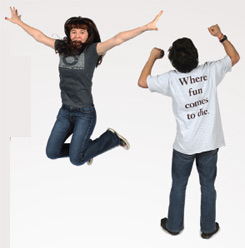Where the Squirrels Are Cuter than Dante and Fun Does Freeze Over
University archivists squirrel away T-shirts where the end of the world began.
By Carrie Golus, AB'91, AM'93
Photography by Dan Dry
The year was 1987, the place was Hale House, and Joel Stitzel, AB’88, had a date with destiny.
Stitzel, who drew various comic strips for the Maroon as an undergrad, was asked to create the design for the house’s fundraising T-shirt. The infamous slogan, as Stitzel recalls, was created by Patrick Paulin, AB’92: “Hell Does Freeze Over.”
The slogan has been repurposed for many other T-shirts over the years, but some aspects of the original shirt have been forgotten, such as Stitzel’s image of the U of C phoenix standing atop a pile of ice cubes. The original also included a Latin motto, “Crescat Tutula, Universitas Ditetur,” which “was supposed to translate as, ‘By Increasing Tuition, Let the University Become Enriched,’” Stitzel says. “But I was relying on a guy named Dan, who swore up and down that he knew Latin—as I’d never taken it—for the translation, and it might not be entirely correct.”
The T-shirts, which were simple black ink on white cotton, were a monster hit, raising so much money for Hale House “that there was a half-serious discussion of ‘seceding’ from the Shoreland, so we wouldn’t have to share it with the rest of the dorm,” says Stitzel. “How we were supposed to get to and from the ninth floor without using building resources like the elevators and staircases was never properly fleshed out.”
Until recently, such T-shirts would have ended up—as Stitzel’s did—buried in a box in the basement. Now the Library’s Special Collections Research Center, where papers and other objects documenting University history are housed, is trying to fill out its T-shirt holdings. The shirts may still end up in a box in the basement, but it will be an archival box, kept at a constant temperature and humidity—and the garments will be available for research and exhibitions. “We treat the T-shirts with just as much care as we do any of our other collections,” says accessions manager Robin Secco.
So far, Special Collections has about 20 shirts, as well as a kimono commemorating a baseball game played against Japan’s Waseda University in 1925. “I wouldn’t call what we have a collection,” says University archivist Daniel Meyer, AM’75, PhD’94. “I would call it ‘a gathering.’” For archivists, “collection” has a specific meaning: it’s intended to be complete or comprehensive. “There are obviously many T-shirts that we would like to have that aren’t here.”
Since Special Collections has no acquisitions funds whatsoever, it is entirely dependent on donations. Many of the shirts “come in at the bottom of a box” when professors or administrators clean out their offices and donate papers, says Meyer. “Maybe there’s a T-shirt there, maybe a mug, maybe a paperweight.”
University T-shirts tend to fall into three primary categories. There are “generalized messages,” Meyer says. “‘Where Fun Comes to Die’ is a T-shirt that works for the whole campus.” (This is Secco’s favorite, tied with the “Reg Rat” shirt: “He’s kind of cute,” she says of the rat.)
There are “cause-related shirts,” such as one created for the 1992–93 Law Women’s Caucus, which juxtaposes a gorgon’s head with antifeminist statements made by televangelist Pat Robertson. Then there are T-shirts that commemorate a specific event, such as the October 1993 inauguration of President Hugo Sonnenschein: “Let the Sonnenschein in.” In some cases, these shirts have so much information, “they are almost the equivalent of a paper document,” says Meyer.
The era of the logo T-shirt began in the 1960s, says Meyer, when the technology for printing T-shirts became much cheaper. Soon afterward, students in campus housing and various clubs began creating shirts for fund-raising purposes, a tradition that is very much alive and well today. The humble tee with the snarky logo (and some of them are all but unprintable) “conveys something about how the university understands itself, how students in particular understand themselves,” says Meyer. “It’s an important part of the documentary record.”
Alumni or students who would like to donate a University T-shirt should contact Robin Secco at rsecco@uchicago.edu. Any documentation, even an approximate date, is very welcome. As to the shirt itself, “the condition doesn’t matter, as long as you can read it,” she says. “And if it’s been washed, that would be highly desirable.”

